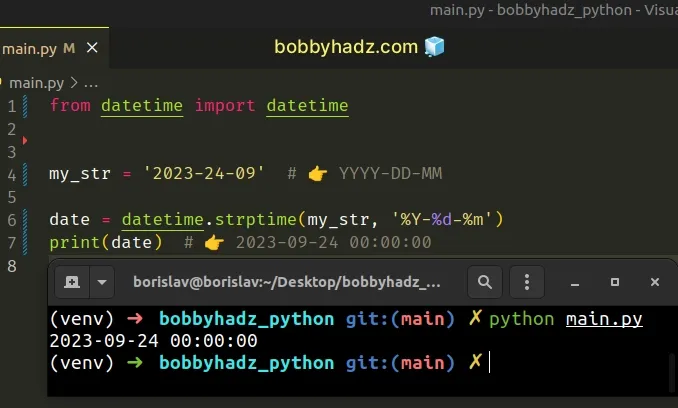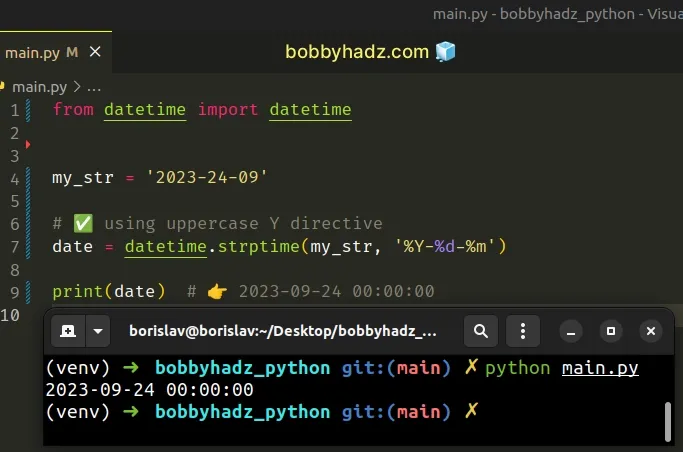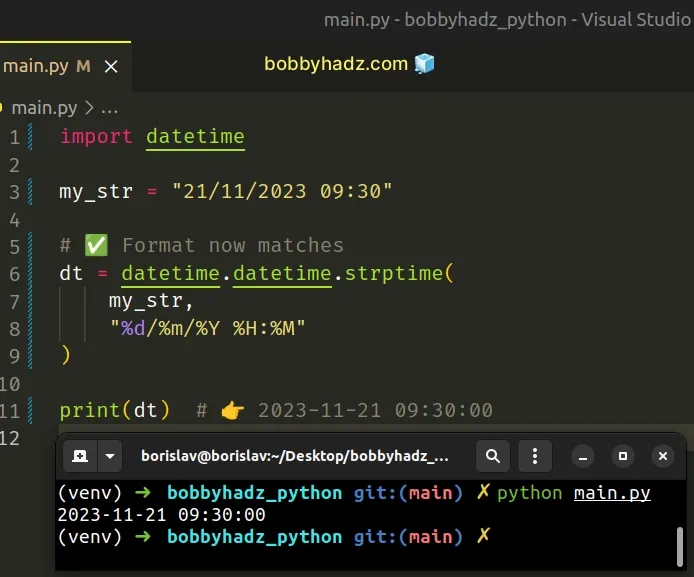ValueError: time data 'X' does not match format '%Y-%m-%d'
Last updated: Apr 10, 2024
Reading time·5 min

# ValueError: time data 'X' does not match format '%Y-%m-%d'
The error "ValueError: time data 'X' does not match format '%Y-%m-%d'" most commonly occurs when:
- There is a formatting issue when calling the
datetime.strptime()method. - The places for the month and the day of the month have been switched.
- Using a lowercase
ywhen formatting (which represents a 2-digit year). - Using incorrect separators in the call to
strptime().

# Swapping the places of the month and day directives
Here is an example of how the error occurs.
from datetime import datetime my_str = '2023-24-09' # 👈️ YYYY-DD-MM # ⛔️ ValueError: time data '2023-24-09' does not match format '%Y-%m-%d' date = datetime.strptime(my_str, '%Y-%m-%d')
Notice that the date string is formatted as YYYY-DD-MM, but we have mixed up
the places of the %m and %d directives in the call to datetime.strptime().
The month can't possibly be 24, so the error is raised.
# Using a correct format for the second argument
The solution, in this case, would be to specify a second argument of %Y-%d-%m.
from datetime import datetime my_str = '2023-24-09' # 👉️ YYYY-DD-MM date = datetime.strptime(my_str, '%Y-%d-%m') print(date) # 👉️ 2023-09-24 00:00:00

datetime.strptime() method.# The lowercase y directive means 2-digit year
Another common cause of the error is using the lowercase y directive which
means 2-digit year (e.g. 23) instead of the uppercase Y directive which means
4-digit year (e.g. 2023).
from datetime import datetime my_str = '2023-24-09' # ⛔️ ValueError: time data '2023-24-09' does not match format '%y-%d-%m' date = datetime.strptime(my_str, '%y-%d-%m')
The year in the example contains 4 digits, so we have to use an uppercase Y
directive.
from datetime import datetime my_str = '2023-24-09' # ✅ Using uppercase Y directive date = datetime.strptime(my_str, '%Y-%d-%m') print(date) # 👉️ 2023-09-24 00:00:00

You can check the meaning of all of the directives in this table in the official docs.
# Specifying incorrect separators in the format string
Another common cause of the error is specifying incorrect separators.
import datetime # 👇️ Forward slashes my_str = "21/11/2023 09:30" # 👇️ Hyphen separators # ⛔️ ValueError: time data '21/11/2023 09:30' does not match format '%d-%m-%Y %H:%M' dt = datetime.datetime.strptime( my_str, "%d-%m-%Y %H:%M" )
Note that the date and time string uses forward slashes as separators for the
day, month and year, however, we used hyphens in the second argument we passed
to strptime().
To solve the error, make sure the format matches by using forward slashes in the format string as well.
import datetime my_str = "21/11/2023 09:30" # ✅ Format now matches dt = datetime.datetime.strptime( my_str, "%d/%m/%Y %H:%M" ) print(dt) # 👉️ 2023-11-21 09:30:00

# Including the Seconds and Microseconds in the format string
Here is a working example of including the seconds and microseconds as well.
import datetime my_str = "21/11/2023 09:30:28.087" dt = datetime.datetime.strptime( my_str, "%d/%m/%Y %H:%M:%S.%f" ) print(dt) # 👉️ 2023-11-21 09:30:28.087000

The separators for the days, months and years are forward slashes and the separators for the hours, minutes and seconds are colons in the example.
You can use this table from the docs to look at the different directives and their meaning.
The
datetime.strptime()
method returns a datetime object that corresponds to the provided date string,
parsed according to the format.
from datetime import datetime d = '2022-11-24 09:30:00.000123' # 👇️ Convert string to datetime object datetime_obj = datetime.strptime(d, '%Y-%m-%d %H:%M:%S.%f') print(datetime_obj) # 👉️ 2022-11-24 09:30:00.000123 # 👇️ Thursday, 24. November 2022 09:30AM print(datetime_obj.strftime("%A, %d. %B %Y %I:%M%p"))
The strptime() method takes the following 2 arguments:
| Name | Description |
|---|---|
| date_string | The date string that is to be converted to a datetime object |
| format | The format string that should be used to parse the date string into a datetime object |
For a complete list of the format codes that the strptime method supports,
check out
this table
of the official docs.
# Setting infer_datetime_format to True if you use pandas
If you use the pandas module to read a CSV file that contains date columns,
try setting the infer_datetime_format keyword argument to True.
import pandas as pd df = pd.read_csv('employees.csv', sep=',', encoding='utf-8') # first_name last_name # 0 Alice Smith # 1 Bobby Hadz # 2 Carl Smith print(df) print('-' * 50) df['date'] = pd.to_datetime(df['date'], infer_datetime_format=True) # first_name last_name date # 0 Alice Smith 1995-01-21 14:32:44.042010 # 1 Bobby Hadz 1998-04-14 12:51:42.014000 print(df)
The code sample assumes that you have an employees.csv file in the same
directory as your main.py file.
first_name,last_name,date Alice,Smith,01/21/1995 14:32:44.042010 Bobby,Hadz,04/14/1998 12:51:42.014000
When the
infer_datetime_format
argument is set to True, pandas attempts to infer the format of the
datetime strings in the columns.
# Using the python-dateutil module instead
An alternative you can try is the python-dateutil module.
First, install the module by running the following command.
pip install python-dateutil # 👇️ for Python 3 pip3 install python-dateutil # 👇️ If you don't have pip in your PATH environment variable python -m pip install python-dateutil python3 -m pip install python-dateutil py -m pip install python-dateutil # 👇️ If you get a permissions error pip install python-dateutil --user # 👇️ For Anaconda conda install -c anaconda python-dateutil
Now import the module and use it to parse a date and time string.
from dateutil import parser dt_string = '20 November, 2023, 3:25:36, pm' # 👇️ 2023-11-20 15:25:36 print(parser.parse(dt_string))
The parser.parse() method parses a string and returns a datetime object.
# Conclusion
To solve the error "ValueError: time data 'X' does not match format '%Y-%m-%d'", make sure:
- There aren't any formatting issues when calling the
datetime.strptime()method. - The places for the month and the day of the month have not been switched.
- You are using the correct directive for the year.
- You are using the correct separators in the format string.
# Additional Resources
You can learn more about the related topics by checking out the following tutorials:
- Check if a variable is a Datetime object in Python
- How to add Hours to Datetime in Python
- How to add Minutes to Datetime in Python
- How to add Seconds to Datetime in Python
- AttributeError module 'datetime' has no attribute 'strptime'
- NameError: name 'time' or 'datetime' is not defined in Python
- How to change the Port and Host in a Flask application
- Python socket.error: [Errno 104] Connection reset by peer
- How to draw empty circles on a Scatter Plot in Matplotlib
- Convert an Image to a Base64-encoded String in Python
- Pandas: Out of bounds nanosecond timestamp [Solved]
- How to get a Quarter from a Date in Pandas [4 Ways]
- How to format datetime or time as AM/PM in Python

